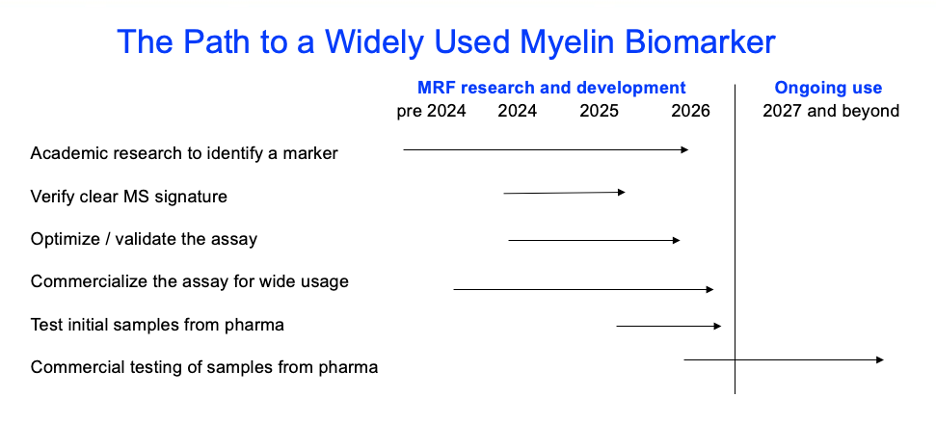President’s Letter:

Scott Johnson, Myelin Repair Foundation President, CEO and Founder … waiting for a cure since 1976
Dear Friends and Supporters of MRF,
In my last update, I shared an exciting and significant milestone: the strong interest in our myelin repair biomarker results, expressed by multiple pharmaceutical executives. Achieving this level of interest allowed us to begin testing / validation steps necessary to ensure wide adoption of our biomarker. Your generous donations made it possible to get to this point, now we need your support to push us over the finish line!
Why is MRF’s biomarker work so important? Currently, while more than 30 pharma companies have myelin repair drug development efforts underway, there is no biomarker to assist their efforts, which is slowing down their progress. MRF’s goal: accelerate myelin repair drug development with our patient-friendly, low-cost biomarker that provides a clear indication of myelin repair and quick, actionable information.
We’re now close to making that goal a reality!
Roadmap for Widespread Adoption of MRF’s Biomarker
Here is our 2025 - 2026 roadmap to ensure we achieve widespread adoption of our myelin repair biomarker. This illustrates how we are moving our MRF-funded development of cutting-edge biomarker assays from academic labs all the way to commercial usage by pharma companies developing MS treatments. An assay is the robust and reproducible procedures that are key to providing the biomarker data / readout that pharma requires of a successful biomarker.

(Click to enlarge)
This path from academic lab to commercial pharma usage is another attribute / activity that sets MRF apart. Most medical non-profit research efforts don’t fund biomarker research and those that do, stop after step 1, with the hope that pharma will take it from there. MRF knew that to ensure widespread use of our biomarker, we needed to perform the testing and validation steps necessary to build pharma trust and accelerate adoption.
Building Pharma Trust, Ensuring Success
MRF has always known that we cannot operate in a vacuum if we are to achieve our goal of widespread adoption of our myelin repair biomarker. To that end, at the outset of our biomarker effort we identified the steps necessary to ensure our process was comprehensive, collaborative, and perhaps most importantly, trusted by pharma.
We’ve funded 35 research studies to identify a biomarker and verify a clear myelin repair signature. Once those key steps were completed, we knew we could accelerate pharma adoption if our team did the work to optimize and validate the assays we developed to find / evaluate the biomarker, and then commercialized that assay for wider use, with the end goal of having pharma send their samples for testing (both initially, and long term on a commercial basis).
Creating Awareness, Gaining Important Recognition
At the same time we have been conducting this research and testing / validation work, we created an awareness campaign to ensure pharma knew about MRF’s biomarker science and progress:
- We identified the right decision makers in companies with myelin repair research programs and scheduled 1:1 meetings to share data as it became available.
Result: Initial feedback has been very positive, as shared in my last President’s Letter. - Scientists that we fund make presentations and exhibit posters at MS Scientific meetings attended by pharma. They also publish papers in scientific journals read by pharma.
Result: Increasing recognition of, and interest in, our work. - Last September, prior to the largest annual MS scientific meeting, MRF conducted a Myelin Repair Biomarker Symposium to discuss our scientific findings.
Result: About 55 people attended from more than two dozen pharma companies, greatly exceeding our expectations.
Amazing Potential of Our Myelin Repair Biomarker
Biomarkers are essential tools used in drug development and treating patients. Our biomarker has the potential to accelerate the development of all MS myelin repair / neuroprotective treatments – both those currently in development and future programs. And it doesn’t stop there. We’re exploring the applicability of our biomarker to help with drug development for other neurological diseases such as ALS, Long COVID, and NMO.
The entire MRF team is pleased and motivated by the progress we have made and the implications for accelerating myelin repair treatments to MS patients that can’t afford to wait.
Your support is needed for us to complete this critical endeavor! Please donate today.
Sincerely,

A Brief Recap of MRF: Our Activities and Accomplishments
Phase 1: Launched myelin repair research (2002 to 2016)
As a non-profit medical research foundation, MRF has always:
- Taken on research challenges that others can’t or won’t
- Coordinated all necessary scientific members in the value chain, combining the strengths and unique skills of each participant to create results-driven outcomes
- Performed crucial functions that efficiently utilized funds donated to MRF and leveraged those dollars for dramatic results.
MRF jump-started basic myelin repair research in academia and demonstrated the possibility of repairing the brain with a therapeutic drug. This has led to increased funding of basic myelin related science by others. In addition, we created the Translation Medicine Center to bridge the gap between academic research results and drug development by pharmaceutical companies. And by funding a myelin repair clinical trial in collaboration with the NIH, we led the way in moving myelin repair compounds toward positive patient outcomes.
MRF’s activities and results reduced the risk associated with myelin repair drug development which paved the way for pharmaceutical companies to begin investing in myelin repair drug research programs. Our pioneering and innovative science investment is why more than 20 companies have myelin repair compounds in various stages of drug development at this time.
Phase 2: Complete our mission by identifying a myelin repair biomarker (2017 to 2026)
The complexity and difficulty of drug development means that industry wide, for compounds that enter preclinical research, only about 1 out of 250 makes it through to FDA approval. The many steps required take over a decade and are very costly. The multiple phases of clinical trials alone can take up to 7 years for an MS treatment.
Based on this, it’s paramount that:
- more compounds enter the pipeline, and
- the compounds are swiftly evaluated in order to expedite availability to MS patients.
Identifying a myelin repair biomarker that clearly indicates whether a compound facilitates myelin repair will make these two objectives a reality.
However, biomarker development is complicated and requires intensive coordination of academics, pharma, biobanks, the NIH, and others — that don’t typically collaborate.
That’s why MRF made it our mission in 2017 to develop a myelin repair biomarker that can speed “Go / No Go” decisions and get myelin repair treatments to patients faster. We knew we had the unique ability and track record required to manage the process. Today, we are executing our comprehensive research roadmap by funding experiments in 11 labs around the world. The biomarker we identify will support all the current myelin repair drug development efforts, PLUS aid in the identification of additional compounds with myelin repair potential.
We are very pleased with the progress we have made and remain confident that we will complete this final MRF objective by the end of 2026.
Your support is needed for us to complete this critical endeavor! Please donate today.
Focus on Biomarkers
The Myelin Repair Foundation is identifying biomarkers to help accelerate myelin repair treatments.